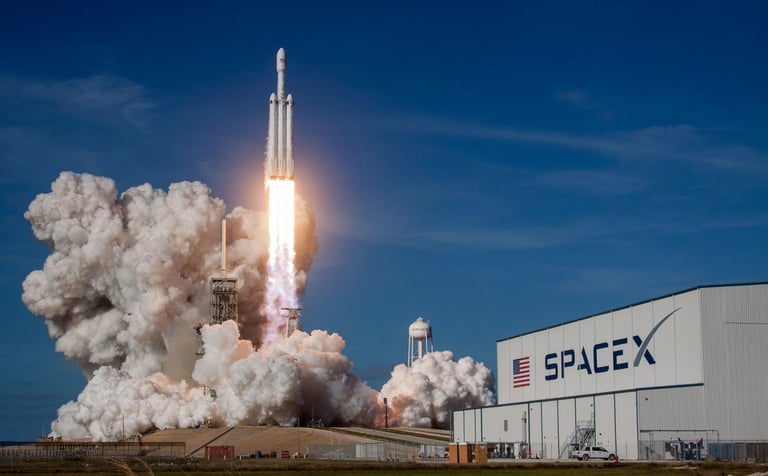SpaceX Starship: Revolutionizing Space Travel with Elon Musk's Vision
INNOVATIONS & TECHNOLOGIES


Introduction to SpaceX Starship
SpaceX Starship, conceived under the visionary leadership of Elon Musk, represents a groundbreaking leap in the field of space exploration. The Starship is a fully reusable spacecraft designed to carry both crew and cargo to a variety of destinations, including Mars, the Moon, and potentially beyond. SpaceX's ambitious goal for Starship is to facilitate human colonization of Mars, thereby transforming interplanetary travel from science fiction into reality.
One of the standout features of Starship is its reusability. Unlike traditional rockets that are discarded after a single use, Starship is designed to be launched, landed, and relaunched multiple times. This innovation significantly reduces the cost of space travel, making it more accessible and sustainable in the long term. The spacecraft's reusability is complemented by its cutting-edge design and advanced engineering, which enable it to achieve a high payload capacity and a broad range of missions.
Starship's development aligns with SpaceX's broader mission of making life multi-planetary. Elon Musk envisions a future where humanity can establish self-sustaining colonies on Mars, thereby ensuring the survival of the species in case of catastrophic events on Earth. This vision extends beyond mere exploration; it encompasses the long-term habitation and potential terraforming of other planets, marking a significant shift in our approach to space travel.
Moreover, Starship aims to revolutionize space travel by offering more frequent and affordable launches. By lowering the cost per launch, SpaceX intends to open up space exploration to a wider array of participants, including scientific communities, commercial enterprises, and even private individuals. This democratization of space travel could spur innovation, foster international collaboration, and accelerate the pace of discoveries beyond our planet.
In essence, SpaceX Starship embodies a bold vision of the future, driven by technological innovation and a profound commitment to expanding humanity's horizons. It stands out not only for its technical prowess but also for its potential to redefine our relationship with space and our place in the universe.
Innovations Brought by Elon Musk
Elon Musk’s vision for the SpaceX Starship has introduced a series of groundbreaking innovations that are set to revolutionize space travel. One of the most notable advancements is the development of the Raptor engines. These engines utilize a full-flow staged combustion cycle, making them more efficient than traditional rocket engines. By using liquid methane and liquid oxygen as propellants, the Raptor engines not only provide a higher thrust-to-weight ratio but also facilitate the possibility of refueling on Mars using in-situ resources. This strategic choice significantly enhances the feasibility of long-duration missions and interplanetary travel.
Another key innovation is the decision to construct the Starship using stainless steel. Unlike conventional aerospace materials, such as aluminum alloys and carbon fiber composites, stainless steel offers superior performance under extreme conditions. Its durability and high melting point make it highly resistant to the thermal stresses encountered during re-entry into Earth's atmosphere. Additionally, stainless steel is significantly less expensive, contributing to a reduction in overall manufacturing costs. This cost-efficiency is a critical factor in SpaceX’s mission to make space travel more accessible.
Perhaps one of the most revolutionary aspects of the Starship is its fully reusable design. Traditional spacecraft are usually expendable, meaning they can only be used once. In contrast, the Starship is designed to be launched, landed, and relaunched multiple times with minimal refurbishment. This reusability drastically reduces the cost per launch, making frequent space missions economically viable. Furthermore, it allows for rapid iteration and improvement of the spacecraft, accelerating technological advancements and operational readiness.
The combination of these innovations—highly efficient Raptor engines, the robust stainless steel structure, and the fully reusable design—culminates in a spacecraft that sets new benchmarks for performance, efficiency, and affordability. These technological advancements are not just incremental improvements but transformative changes that have the potential to make space travel a routine reality, bringing humanity closer to exploring and perhaps even colonizing other planets.
Engineering Marvel: How Starship Works
SpaceX's Starship represents a pinnacle of modern engineering, merging innovative design with cutting-edge technology. Central to its functionality is the two-stage system comprising the Super Heavy booster and the Starship spacecraft. This dual-stage mechanism is designed to optimize efficiency and payload capacity, ensuring the spacecraft can undertake a variety of missions, from low Earth orbit (LEO) to interplanetary travel.
The Super Heavy booster forms the first stage of the Starship system. This massive booster is equipped with numerous Raptor engines, each powered by a combination of liquid methane and liquid oxygen. The choice of methane as a fuel source is a significant departure from traditional rocket propellants like RP-1 kerosene. Methane offers higher efficiency and produces fewer byproducts, making the engines easier to reuse. Moreover, methane can potentially be synthesized on Mars, aligning with SpaceX's vision of sustainable interplanetary travel.
Upon launch, the Super Heavy booster propels the Starship spacecraft out of Earth's atmosphere. Once its fuel is expended, the booster detaches and returns to Earth, where it is designed to land vertically, akin to SpaceX's Falcon 9 rockets. This reusability is crucial as it dramatically reduces the cost of space missions, making frequent launches economically viable.
The second stage, the Starship spacecraft itself, continues its journey post-separation. This segment is also powered by Raptor engines, and its design incorporates a large payload capacity, ample crew quarters, and advanced life-support systems. The spacecraft's exterior is coated with a heat shield to withstand the intense heat during re-entry into Earth's atmosphere or any other celestial body.
Starship's landing mechanism is another marvel of engineering. The spacecraft employs a controlled descent using its engines, allowing it to touchdown vertically. This capability is vital for missions to the Moon and Mars, where safe and precise landings are paramount.
The overall design principles of Starship emphasize efficiency, safety, and reusability. Every aspect, from the choice of materials to the integration of advanced technologies, underscores SpaceX's commitment to revolutionizing space travel. By leveraging reusability and the advantages of methane fuel, Starship stands as a testament to human ingenuity and the relentless pursuit of making space travel more accessible and sustainable.
Missions and Milestones
SpaceX Starship has marked significant milestones in the realm of space travel, showcasing a series of groundbreaking missions and achievements. One of the most notable test flights was the Starship SN8, which launched in December 2020. Despite an explosive landing, the mission provided valuable data, propelling further advancements in design and safety protocols. Subsequent iterations, such as SN9 and SN10, demonstrated incremental improvements, with SN10 achieving a successful landing, albeit followed by an explosion minutes later.
Progress continued with the SN15, which completed a high-altitude flight and a successful landing in May 2021, marking a crucial milestone in SpaceX's development timeline. The orbital launch attempts have also been a focus, with the Super Heavy booster and Starship integrated tests highlighting the potential for reaching orbit and beyond. Each test flight contributes to refining the vehicle’s technology, preparing it for more ambitious missions.
Challenges and setbacks have been part of the journey, including engine failures and structural issues. However, SpaceX’s iterative approach, characterized by rapid prototyping and real-time problem solving, has been instrumental in overcoming these obstacles. This methodology allows for swift adaptations and improvements, ensuring continuous progress.
Partnerships and collaborations have played a pivotal role in Starship's advancement. NASA's selection of SpaceX Starship for the Artemis program, aimed at returning humans to the Moon, underscores the spacecraft's potential. Additionally, collaborations with private entities, such as the lunar tourism mission with Japanese entrepreneur Yusaku Maezawa, highlight the expanding scope of Starship’s applications.
Collectively, these missions and milestones underscore SpaceX's commitment to revolutionizing space travel, driven by Elon Musk's vision of creating a multi-planetary future. As development progresses, the Starship continues to break barriers, pushing the boundaries of what is possible in space exploration.
The Future of SpaceX Starship
SpaceX's Starship is poised to redefine the boundaries of space travel, with a future that promises groundbreaking missions and significant advancements across various industries. One of the most notable upcoming missions for Starship is its involvement in NASA's Artemis program, which aims to return humans to the Moon by 2024. Starship is slated to serve as the lunar lander, playing a crucial role in delivering astronauts to the Moon's surface and facilitating extended lunar exploration. This mission not only demonstrates Starship's capability but also marks a significant step towards sustainable human presence beyond Earth.
Beyond the Moon, SpaceX's ambitious goal of colonizing Mars is perhaps the most visionary aspect of Starship's future. Elon Musk envisions a fleet of Starships capable of transporting large numbers of people and cargo to the Red Planet, ultimately establishing a self-sustaining Martian colony. This endeavor, while fraught with technical and logistical challenges, is driven by the belief that humanity's future lies in becoming a multiplanetary species. The success of Mars colonization could revolutionize our understanding of life in the universe and pave the way for further interplanetary exploration.
In addition to these grandiose missions, Starship has the potential to revolutionize other sectors such as space tourism, satellite deployment, and interplanetary travel. With its fully reusable design, Starship promises to significantly reduce the cost of space access, making space tourism more accessible to private individuals. Companies could also benefit from more efficient satellite deployment, while the prospect of rapid interplanetary travel opens new avenues for scientific research and exploration.
However, the path forward is not without its challenges. Technical hurdles, regulatory approvals, and the need for sustainable life support systems in space are just a few of the obstacles that SpaceX must overcome. Nonetheless, the roadmap laid out by Elon Musk and SpaceX is a testament to the human spirit of exploration and innovation, promising a future where space travel is not just a dream, but a reality within reach.
Conclusion: Transforming Space Travel Forever
SpaceX Starship represents a monumental leap in the field of space travel, embodying Elon Musk's ambitious vision for interplanetary exploration. Throughout this blog post, we have delved into the innovative design and engineering feats that set Starship apart from any other spacecraft. The spacecraft's reusability, advanced propulsion systems, and significant payload capacity underscore its potential to revolutionize space travel, making missions to Mars and beyond more feasible and economically viable.
Elon Musk's vision transcends merely reaching other planets; it encompasses the establishment of a sustainable human presence in space. This vision is a driving force behind the relentless pursuit of technological advancements and the continuous refinement of the Starship project. By pushing the boundaries of what is possible, SpaceX is not only facilitating the possibility of interplanetary travel but also inspiring a new era of space exploration that could unlock unprecedented opportunities for scientific discovery and human advancement.
The broader implications of SpaceX Starship for humanity are profound. The ability to transport large numbers of people and substantial cargo to extraterrestrial destinations opens up the potential for colonization, resource utilization, and expanded scientific research. This could lead to significant breakthroughs in our understanding of the universe and our place within it. Moreover, the advancements made by SpaceX are likely to drive competition and innovation within the aerospace industry, further accelerating progress in space exploration.
As we stand on the brink of this new frontier, it is essential for enthusiasts and the general public alike to stay informed about the ongoing developments in space exploration. The journey of SpaceX Starship is a continually evolving story, one that promises to bring exciting advancements and discoveries. By following these developments, we can witness firsthand the unfolding of a new chapter in human history, one where space travel is no longer a distant dream but an achievable reality.


